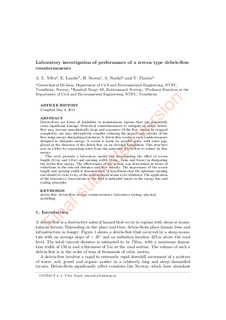| dc.contributor.author | Yifru, Ashenafi Lulseged | |
| dc.contributor.author | Laache, Emilie | |
| dc.contributor.author | Norem, Harald Anders | |
| dc.contributor.author | Nordal, Steinar | |
| dc.contributor.author | Thakur, Vikas Kumar Singh | |
| dc.date.accessioned | 2019-08-14T12:28:42Z | |
| dc.date.available | 2019-08-14T12:28:42Z | |
| dc.date.created | 2018-08-03T14:15:25Z | |
| dc.date.issued | 2018 | |
| dc.identifier.citation | HKIE Transactions. 2018, 25 (2), 129-144. | nb_NO |
| dc.identifier.issn | 1023-697X | |
| dc.identifier.uri | http://hdl.handle.net/11250/2608308 | |
| dc.description.abstract | Debris-flows are forms of landslides in mountainous regions that can potentially cause significant damage. Structural countermeasures to mitigate an entire debris-flow may become unrealistically massive and expensive. If the flow cannot be stopped completely, one may alternatively consider reducing the impact and velocity of the flow using energy dissipating structures. A debris-flow screen is such a countermeasure designed to dissipate energy. A screen is made by parallel grids, with some gaps, placed in the direction of the debris-flow on an elevated foundation. This structure acts as a filter for separating water from the saturated debris-flow to reduce its flow energy. This paper presents a laboratory model test investigating the effect of the screen with length (0.5 m and 1.0 m) and opening width (2 mm, 4 mm and 6 mm) in dissipating the debris-flow energy. The effectiveness of the screens was determined in terms of reductions in the run-out distance and the flow velocity. The importance of the screen length and the opening width is demonstrated. A hypothesis that the optimum opening size should be close to of the solid material seems to be validated. The application of the laboratory observations to the field is indicated based on the energy line and scaling principles. | nb_NO |
| dc.language.iso | eng | nb_NO |
| dc.publisher | Taylor & Francis | nb_NO |
| dc.title | Laboratory investigation of performance of a screen type debris-flow countermeasure | nb_NO |
| dc.type | Journal article | nb_NO |
| dc.type | Peer reviewed | nb_NO |
| dc.description.version | acceptedVersion | nb_NO |
| dc.source.pagenumber | 129-144 | nb_NO |
| dc.source.volume | 25 | nb_NO |
| dc.source.journal | HKIE Transactions | nb_NO |
| dc.source.issue | 2 | nb_NO |
| dc.identifier.doi | 10.1080/1023697X.2018.1462104 | |
| dc.identifier.cristin | 1599655 | |
| dc.relation.project | Statens Vegvesen: 25137200 | nb_NO |
| dc.description.localcode | This is an [Accepted Manuscript] of an article published by Taylor & Francis in [HKIE Transactions] on [31 Jul 2018], available at https://doi.org/10.1080/1023697X.2018.1462104 | nb_NO |
| cristin.unitcode | 194,64,91,0 | |
| cristin.unitname | Institutt for bygg- og miljøteknikk | |
| cristin.ispublished | true | |
| cristin.fulltext | preprint | |
| cristin.qualitycode | 1 | |
